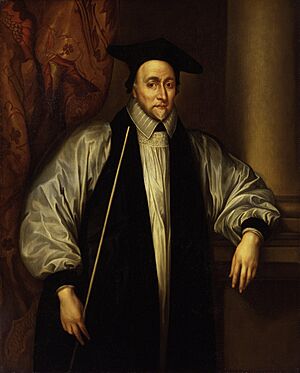William Juxon facts for kids
Quick facts for kids The Most Reverend and Right Honourable William Juxon |
|
|---|---|
| Archbishop of Canterbury | |
 |
|
| Church | Church of England |
| Province | Province of Canterbury |
| Diocese | Diocese of Canterbury |
| Elected | 13 September 1660 (elected); 20 September 1660 (election confirmed), Henry VII Chapel, Westminster Abbey |
| Enthroned | 25 September 1660 |
| Reign ended | 4 June 1663 (death) |
| Predecessor | William Laud |
| Successor | Gilbert Sheldon |
| Other posts |
|
| Personal details | |
| Born | 1582 Chichester, Sussex, England |
| Died | 4 June 1663 (aged approximately 81) Lambeth, Surrey, England |
| Buried | 9 July 1663, Chapel of St John's College, Oxford |
| Nationality | English |
| Denomination | Anglican |
| Parents | Richard Juxon |
| Occupation | also a minister of the Crown |
| Profession | Lawyer; academic |
| Education | Merchant Taylors' School |
| Alma mater | St John's College, Oxford |
| Signature | |
William Juxon (born 1582 – died 4 June 1663) was an important English church leader. He served as the Bishop of London from 1633 to 1646. Later, he became the Archbishop of Canterbury in 1660, a role he held until his death.
Contents
William Juxon's Life Story
Early Years and Education
William Juxon was born in 1582, likely in Chichester, England. His father was Richard Juxon. William first attended The Prebendal School, a local grammar school.
After that, he went to Merchant Taylors' School in London. He then earned a scholarship to St John's College, Oxford in 1598.
Church Career and Leadership
Juxon first studied law at Oxford University. However, he later decided to become a priest. In 1609, he became the vicar of St Giles' Church, Oxford. He then moved to be the rector of Somerton, Oxfordshire in 1615.
In 1621, Juxon took over from his friend, William Laud, as the head of St John's College. He also served as the Vice-Chancellor of the University of Oxford in 1626 and 1627. These were important leadership roles at the university.
Juxon quickly gained more important positions. In 1632, he became the Clerk of the Closet for King Charles I. This meant he was a close advisor to the King on religious matters.
In 1627, he was made the Dean of Worcester. In 1632, he was chosen to become the Bishop of Hereford. He officially became Bishop of Hereford in July 1633. However, he never actually worked there. In October 1633, he was made the Bishop of London, taking over from William Laud.
Working for the King
In March 1636, King Charles I gave Juxon very important jobs outside the church. He made him the Lord High Treasurer of England. This meant Juxon was in charge of the country's money. He also became the First Lord of the Admiralty, overseeing the navy.
For the next five years, Juxon faced many money problems and other challenges. He left these roles in May 1641.
During the English Civil War, Juxon stayed at Fulham Palace. He was not accused of any crimes by Parliament. The King trusted Juxon greatly and often asked for his advice. King Charles I chose Juxon to be with him at his execution. Juxon was there to offer the King comfort and prayers.
Retirement and Return to Power
Parliament removed Juxon from his role as Bishop of London in October 1646. During the time of the Commonwealth and The Protectorate, the system of bishops was stopped.
Juxon then moved to Little Compton. He had bought an estate there. He became known for owning a group of hunting dogs.
When Charles II became King again in 1660 (this was called the Restoration), Juxon was asked to return. He was made Archbishop of Canterbury, the most important church leader in England. He officially took office on 20 September 1660.
As Archbishop, Juxon helped crown the new King. However, his health soon began to fail. He died at Lambeth in 1663.
In his will, Juxon left money to St John's College, Oxford, where he was buried. He also helped pay for repairs to St Paul's Cathedral and rebuilt the great hall at Lambeth Palace.
Remembering William Juxon
Several places are named after William Juxon. Juxon House is a building near St Paul's Cathedral in London. It is part of the Paternoster Square area.
There is also a Juxon Street in Jericho, Oxford. This land used to belong to St John's College. Another Juxon Street is in Lambeth Walk, close to where Juxon lived at Lambeth Palace.

